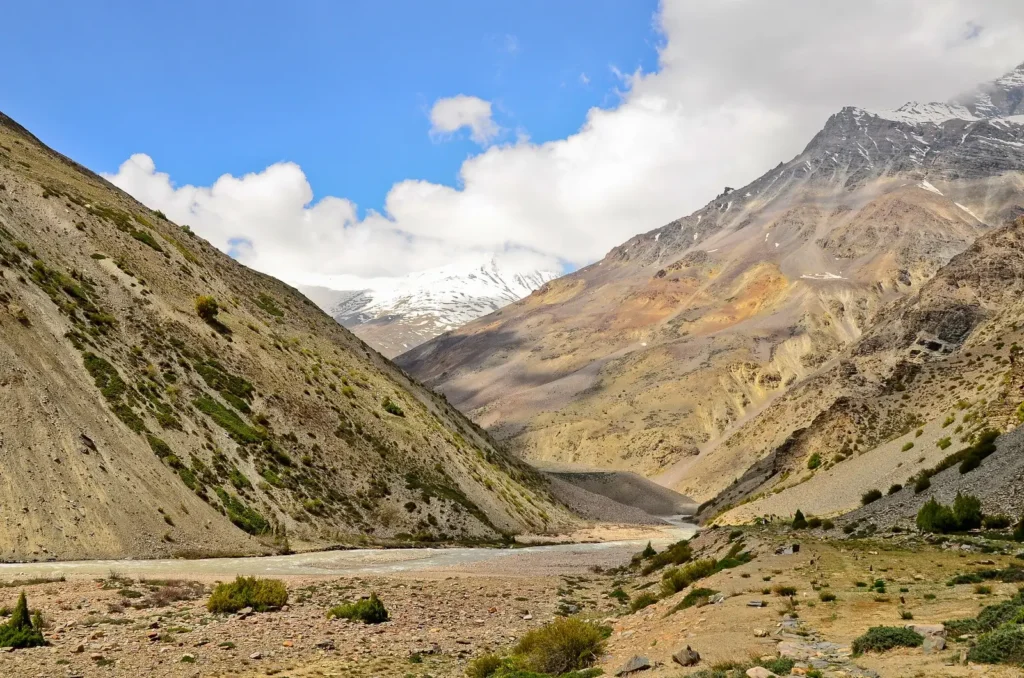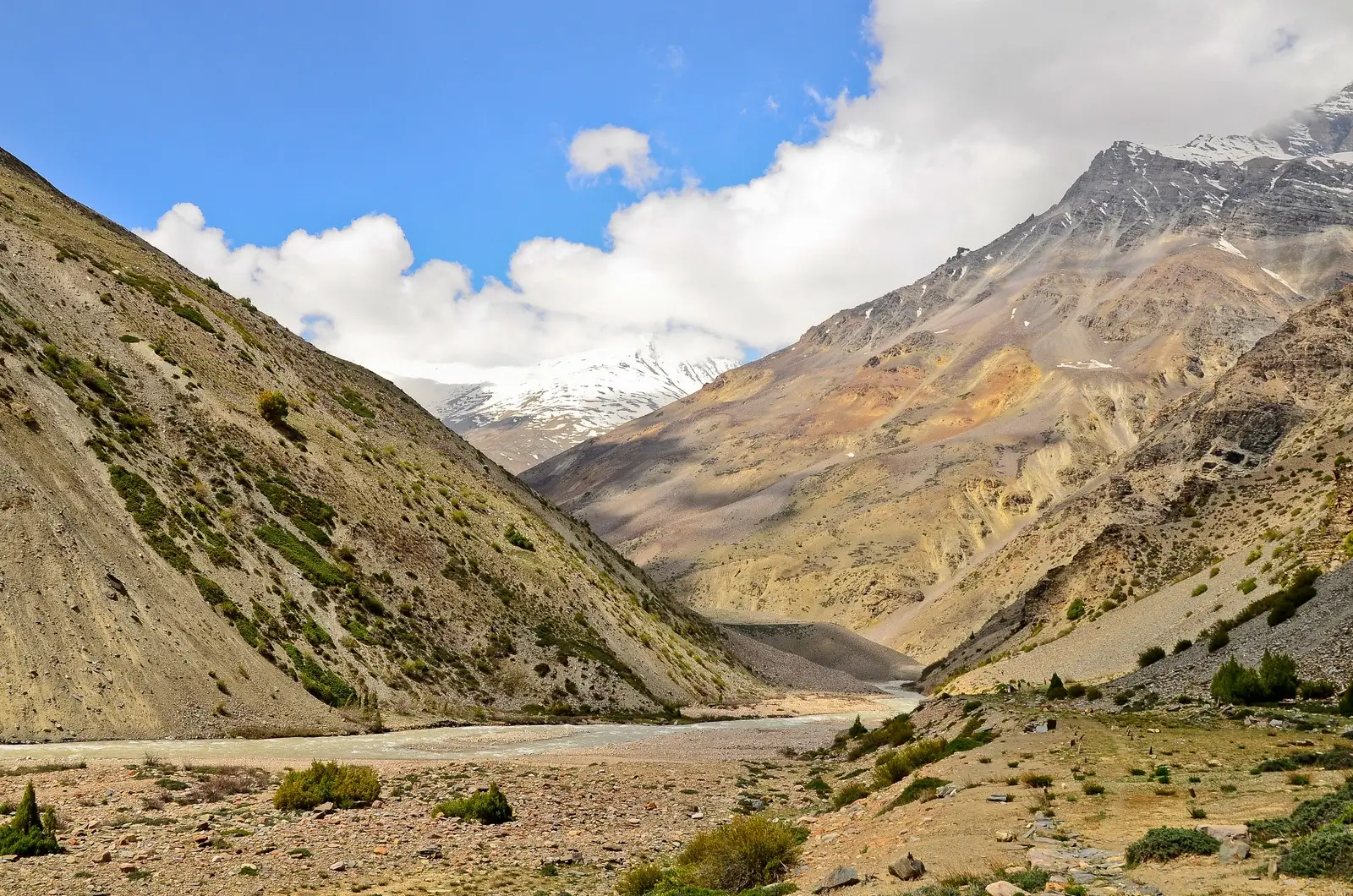Nelong Valley, located within Gangotri National Park in Uttarkashi, Uttarakhand, is a high-altitude river valley resembling the landscapes of Lahul, Ladakh, and Tibet. Due to this resemblance, the valley is known as the “Ladakh of Uttarakhand.” The valley shares its border with the Kinnaur district of Himachal and Tibet.
Are you looking for a tailored-made tour package to visit Nelong Valley? Find the details below:
Table of Contents

Every year, tourists visit this valley to explore this lesser-known part of the Garhwal Himalayas of Uttarakhand and Gartang Gali. From Bhaironghati, which is on NH34, there’s a road that diverts to Nelong Valley (NH134A). Nelong Valley is 229 km from Dehradun, 91 km from Uttarkashi, 18 km from Harsil, and 9 km from Gangotri.
To enter the valley, one needs to obtain a Nelong Valley Permit from the SDM office in Uttarkashi. Overnight stay is not allowed, so one must return to the Bhaironghati Check Post before evening. The motorable road is maintained by the BRO under the India-China Border Road Programmes.
You can drive up to 23 km from Bhaironghati Forest Check Post to the Nelong Valley Checkpost (3,500 m / 11,485 ft). There was once a village at this check post, Nelong Village, but now only the ruins remain. Further ahead are other villages of the valley and Janak Tal, and to go there, you need permission, which is given in special cases only. The villages were inhabited by the Jadh tribe once. Nelong, Jadhang Village, Sumla, Dumka, Pulam Sumda, and Keelang were some of the villages here before the 1962 Sino-Indian War.
The road to Nelong Check Post runs along the Jaad Ganga River. En route, you will cross various bridges and water streams to reach your destination. About 4-5 km from Bhaironghati, you will come across Hawa Bend, known for strong winds, Pagal Nala, known for sudden flash floods, and Hindola Gad (14 km from Bhaironghati Check Post), a section known for the “swing” experienced by travelers on the route.
Itinerary to Follow
Option 1:
- Day 1: Reach Harsil Valley from your city.
- Day 2: Start your journey to Nelong Valley and return to Harsil by evening.
- Day 3: Leave for your home city.
Option 2:
- Day 1: Reach Harsil from your city.
- Day 2: Explore Bagori village and nearby places like Lama Top and Sattal.
- Day 3: Explore Gartang Gali and Nelong Valley and return to Harsil by evening.
- Day 4: Leave for your home city.
You can also add Gangotri to your itinerary if you have time. If you are eager to learn more about the culture, history, and livelihood of the Jadh tribe then visit Bagori village before your visit to Nelong.

Best Time to Visit Nelong Valley
Nelong Valley is located within Gangotri National Park, so the opening and closing times of the National Park also apply to the valley. The National Park opens in April, and tourist visits are allowed only after forest officials complete their reconnaissance. In April, the National Park is still covered with snow, as is Nelong Valley. The best time to visit the nelong valley is from May to June and mid-September to mid-October.
- May – June (Summers): May to June is the best time to visit the valley as the temperatures are moderate, and most of the snow on the route either melts or is cleared by BRO. It doesn’t rain during these months, so the chances of landslides along the route from Dehradun to Harsil are minimal.
- Mid-September to Mid-October (Autumn): Usually, the monsoon ends by the first week of September in Uttarakhand. From mid-September, autumn starts, which means clear skies and no rainfall. The temperature during these months is cooler compared to the summer months. Make sure to keep winter clothes as required.
How to reach Nelong Valley
It’s best to use a personal vehicle to visit Nelong Valley. To enter Nelong you need to reach Uttarkashi or Harsil. Here’s a guide on how to reach Uttarkashi.
Delhi to Nelong distance is around 534 km away. Take the Delhi – Meerut – Muzaffarnagar – Saharanpur route and you will reach Dehradun within 6 hours. Currently, an expressway is in the making which will reduce the time even further but as of now, this route is best. Once you have reached Dehradun take Suwakholi, Chinyalisaur route and reach Uttarkashi. You can have your stay at Uttarkashi or Harsil. Harsil is better if you want serene and peaceful surroundings. Harsil to Nelong Valley distance is about 18 km and you will take a route to Nelong from Bhaironghati.
Temperature in Nelong Valley
Nelong Valley is visited only during the daytime, so the temperatures mentioned here reflect daytime conditions.
- May to June: 15 degrees to 2 degrees
- Mid-September to Mid-October: 10 degrees to -5 degrees

Things to Carry Nelong
- Permit from SDM
- Aadhaar Card
- RC of vehicle
- Driving Licence
- Water bottle
- Snacks (Don’t litter plastic anywhere)
- Sunglasses
- Sun cap
- Sunscreen
- Moisturizer
- Winter clothes like a jacket, gloves, and cap
History
The valley, due to its shared border with the Bushahr Kingdom and the Tibet Empire, was the subject of claim among the three parties at various times in history.1 During the pre-British era and the British era, there were many dialogues between the Bushahr Kingdom, the Tibet Empire, the Tehri State, and British India.
It’s said that in 1914 Dzongpen (refers to the local ruler or governor in Tibet) of Tsaparang/Chaprung visited the valley and tried to set up a boundary pillar, but the local people objected, and he left.23 Between 1914 and 1921, there were multiple dialogues between Dzongpen and the Tehri State regarding the boundary. The Tehri State raised the issue through the British India government as this was an international border matter. Between 1921 and before Tibet was occupied by the Chinese Army, there were many dialogues between British India and Lhasa.4

Later, Tibet was occupied by the Chinese Army, and the Chinese Army also claimed the territory. To date, China claims the valley under Zanda County, Tibet5.
Before the Sino-Indian War of 1962, Nelong and other villages were residences of the Jadh Bhotiya tribe. The Jadh of Kinnaur and Nelong had trade ties with Tibet, and people from here used to go to Tibet regularly for trade. However, due to the war, all the villages were evacuated by 1965, and the Jad community was settled in Bagori and Dunda.
The valley was closed for nearly 53 years, and only army movements were allowed. Finally, in 2015, the government opened the valley for travelers with a few conditions like obtaining an inner line permit, no overnight stay, and no foreigners allowed within the valley.6
Geography, Fauna, and Watershed of Nelong
Known as the “Ladakh of Uttarakhand,” the valley is like a cold desert with rocky terrain, minimal vegetation, and low rainfall. Wildlife found in the valley includes the brown bear, Himalayan blue sheep, and snow leopard.7
Within the valley, there are multiple water streams that eventually join and become Jaad Ganga, which then joins the Bhagirathi River in Bhaironghati. A few of the “Gad” (streams) are Tirpani Gad, Chor Gad, Mana Gad, and Jadhung Gad.8

Important Points:
- Obtain the Inner Line Permit prior to your visit
- Stay options are at Harsil and GMVN Bhaironghati
- Keep food with you as there are no shops or dhabas within the valley. Water is plenty which you can fill from the glacial streams.
- Follow Leave No Trace principals
- Private vehicles are allowed.
- Two-wheelers are not allowed
- Overnight stay is not allowed
- Drones are not allowed
- Keep warm clothes with you
- Don’t cross water streams without prior checking
- Don’t disturb wildlife
References
- Exploring the Valley of Jadhs https://www.himalayanclub.org/hj/69/7/exploring-the-valley-of-the-jadhs/ ↩︎
- The Last Indian Villages On Tibet Border https://www.rediff.com/news/special/the-last-indian-villages-on-tibet-border/20240523.htm ↩︎
- Nilang Valley reopened https://claudearpi.blogspot.com/2015/12/nilang-valley-reopened-to-tourism.html ↩︎
- Exploring the Valley of Jadhs https://www.himalayanclub.org/hj/69/7/exploring-the-valley-of-the-jadhs/ ↩︎
- Wikipedia https://en.wikipedia.org/wiki/Nelang ↩︎
- https://www.thehindu.com/news/national/other-states/nelong-valley-opens-for-tourists-first-time-since-1962/article7232872.ece ↩︎
- Snow Leopard sighting in https://www.etvbharat.com/english/state/uttarakhand/snow-leopard-spotted-in-uttarakhand/na20230317145745636636541 ↩︎
- Jadh Ganga Wikipedia https://en.wikipedia.org/wiki/Jadh_Ganga ↩︎


Leave a Comment